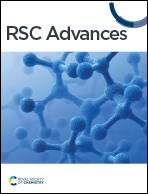Preparation and properties of cellulose nanocrystal-based ion-conductive hydrogels
Abstract
Ion-conductive hydrogels were prepared by a simple one-pot method based on cellulose nanocrystals (CNC) and polyvinyl alcohol (PVA). PVA–CNC hydrogels were prepared with different contents of CNC and Al3+ ions to enhance the performance of ion-conductive hydrogels. The samples were characterized by Fourier transform infrared spectroscopy, universal testing machine, LCR digital bridge and scanning electron microscopy analyses. The results show that DMSO solvent can enhance the anti-freezing and moisture retention property of the polyvinyl alcohol hydrogel. With the increase of CNC content in the hydrogels, their mechanical properties are also improved. When the CNC concentration is 0.2 wt%, the maximum tensile strength and elongation at break are 750 KPa and 410.47%, respectively. Compared to the hydrogel without CNC, the tensile strength of the hydrogel with 0.2 wt% CNC was increased to 733% and elongation at break was increased to 236%. However, the mechanical properties of the hydrogel will decrease when the CNC content increases to 0.25 wt%. When the hydrogel is stretched, the relative resistance of the hydrogel increases with the increase of tensile deformation. The hydrogels can also be assembled to form self-powered batteries with a voltage of 0.808 V. This indicates that the hydrogels have potential application value in flexible sensors.



 Please wait while we load your content...
Please wait while we load your content...